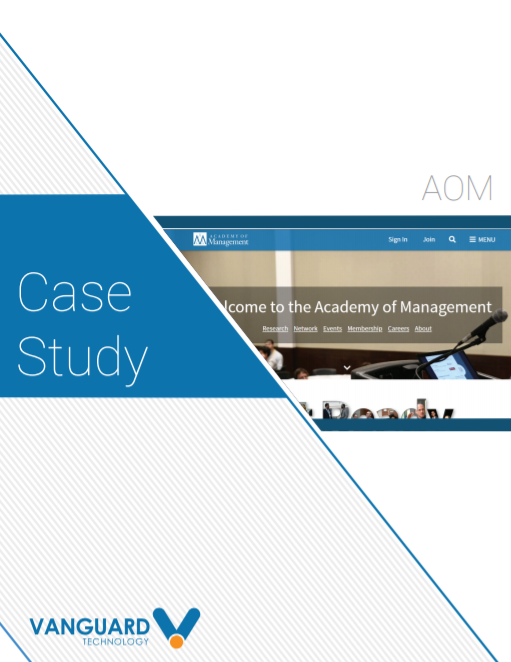Web Smarts - Business Savvy
We’ve been building websites since 1998
We are trusted advisors to Over 50 Active Clients within several industries including associations and nonprofits, healthcare, financial services, retail, B2B and more.

We Are
Trusted
Partners
After we deliver a quality website on time and within your budget, we will be there for when it really counts. We will be proactive, consultative and strategic after we launch your website.

We Are
Integration
Experts
We’ve integrated with virtually every AMS system on the market as well as most LMS, publication, advocacy and career center applications. Our company was founded on custom development.

We build websites that are easy to edit, manage and design using the best content management system on the market, Sitefinity CMS.
We Provide A Full Spectrum Of Services
Our Clients Are Our Partners....
John Wurm

The team at Vanguard helped us think about our digital presence from the perspective and needs of our users, while holding true to the values our organization espouses.
Connect With Us
Improve Your Webcopy

The
Vanguard View
Technology articles about one topic from the perspective of Leadership, Marketing and IT professionals .
Three Website Performance Tools
First impressions are everything, and nothing turns a user away faster than a website that takes a long time to load. With today’s internet speed, users expect quick load times. The website industry states that a website should load between two and five seconds. With more and more users accessing the web through their mobile device, anything beyond two seconds is a detriment. It is known in the business world that a slow website causes decreased user participation and disengagement. In 2006, Amazon reported that for every 100 milliseconds they speed up their website, they see a 1% increase in revenue. Consider SEO when you think of your site’s performance.
The search engines consider the page load speed as an essential parameter for user engagement; hence it is also factored into the web page ranking.
There are practical options available to boost your website’s performance. As a website developer, let me share a few quick tips with you.
1. Use a CDN (Content Delivery Network)
A CDN is a large network of servers hosting identical content in locations all around the world. When a website requests an image, the CDN finds the closest server to transmit the information. You should use a CDN to improve the site visitor’s experience by delivering the content faster, reducing the traffic load on your web server. The idea behind using a CDN is that you can render multiple images, documents and video with a single request as opposed to having multiple requests to your web server for the same information. The fewer request made to the server, the faster your website will become. Sitefinity can easily integrate with your CDN.
2. Use Caching
Caching is a mechanism in which information is saved in a temporary location for future use. Caching allows you to efficiently reuse previously retrieved or computed data. The ability to cache and reuse previously fetched resources is a critical aspect of optimizing for performance. Browser’s cache could store most, if not all, content from a single webpage.
There are two caching mechanisms. One is your browser’s cache and the other is the web server cache.
The web server stores application data. When you need a list of all news items, for example, the server will check to see if a cached version of the SQL query is available and serves that information as opposed to recompiling the list from scratch. Application level caches take care of storing data that takes a longer time to process (e.g. DB queries, configuration files, etc.) and serving it from the web server memory. The browser cache can only store static content like images, text, JavaScript and CSS files.
If the browser has a cached version of static files within a webpage, the browser will simply deliver the static content from the browser’s memory. The browser will not have to send a request to the webserver for the information. As mentioned above, the fewer requests to the server, the lower the site speed. The web browser just needs to know if it can save and store the information received from the server.
The website owner needs to simply set the HTTP header directives to instruct the browser when and for how long it can cache the response. Sitefinity allows website administrators to set browser caching directives. The web hosting company sets the server caching parameters.
3. Image Optimization
Image Optimization is reducing the image file size as much as possible without ruining the graphic integrity. If you are not using a CDN, consider the impact that a single image on a webpage can ruin the site speed. Typically, our rule of thumb is to try to keep each image around 500 KB. Be sure that your images are no larger than they need to be, that they are in the right file format (PNGs are generally better for graphics with fewer than 16 colors while JPEGs are generally better for photographs), and that they are compressed for the web. PNG is a lossless format that can be highly compressed. Sitefinity has a built-in image crop tool to help you reduce the site of your images.
These are just a few tricks to help your site reach the optimized load time. There are many other options that are available. If your website is experiencing slow load time, we can help! Reach out to your Vanguard client service manager to discuss the options available to you.
Vanguard Tips & Tricks
We provide helpful hints you never knew you needed for our clients. Check out "Vanguard Tips & Tricks" to learn quick and simple hacks to make managing your website easier than ever.
Three Website Performance Tools
First impressions are everything, and nothing turns a user away faster than a website that takes a long time to load. With today’s internet speed, users expect quick load times. The website industry states that a website should load between two and five seconds. With more and more users accessing the web through their mobile device, anything beyond two seconds is a detriment. It is known in the business world that a slow website causes decreased user participation and disengagement. In 2006, Amazon reported that for every 100 milliseconds they speed up their website, they see a 1% increase in revenue. Consider SEO when you think of your site’s performance.
The search engines consider the page load speed as an essential parameter for user engagement; hence it is also factored into the web page ranking.
There are practical options available to boost your website’s performance. As a website developer, let me share a few quick tips with you.
1. Use a CDN (Content Delivery Network)
A CDN is a large network of servers hosting identical content in locations all around the world. When a website requests an image, the CDN finds the closest server to transmit the information. You should use a CDN to improve the site visitor’s experience by delivering the content faster, reducing the traffic load on your web server. The idea behind using a CDN is that you can render multiple images, documents and video with a single request as opposed to having multiple requests to your web server for the same information. The fewer request made to the server, the faster your website will become. Sitefinity can easily integrate with your CDN.
2. Use Caching
Caching is a mechanism in which information is saved in a temporary location for future use. Caching allows you to efficiently reuse previously retrieved or computed data. The ability to cache and reuse previously fetched resources is a critical aspect of optimizing for performance. Browser’s cache could store most, if not all, content from a single webpage.
There are two caching mechanisms. One is your browser’s cache and the other is the web server cache.
The web server stores application data. When you need a list of all news items, for example, the server will check to see if a cached version of the SQL query is available and serves that information as opposed to recompiling the list from scratch. Application level caches take care of storing data that takes a longer time to process (e.g. DB queries, configuration files, etc.) and serving it from the web server memory. The browser cache can only store static content like images, text, JavaScript and CSS files.
If the browser has a cached version of static files within a webpage, the browser will simply deliver the static content from the browser’s memory. The browser will not have to send a request to the webserver for the information. As mentioned above, the fewer requests to the server, the lower the site speed. The web browser just needs to know if it can save and store the information received from the server.
The website owner needs to simply set the HTTP header directives to instruct the browser when and for how long it can cache the response. Sitefinity allows website administrators to set browser caching directives. The web hosting company sets the server caching parameters.
3. Image Optimization
Image Optimization is reducing the image file size as much as possible without ruining the graphic integrity. If you are not using a CDN, consider the impact that a single image on a webpage can ruin the site speed. Typically, our rule of thumb is to try to keep each image around 500 KB. Be sure that your images are no larger than they need to be, that they are in the right file format (PNGs are generally better for graphics with fewer than 16 colors while JPEGs are generally better for photographs), and that they are compressed for the web. PNG is a lossless format that can be highly compressed. Sitefinity has a built-in image crop tool to help you reduce the site of your images.
These are just a few tricks to help your site reach the optimized load time. There are many other options that are available. If your website is experiencing slow load time, we can help! Reach out to your Vanguard client service manager to discuss the options available to you.
Case Studies
Vanguard conducts thorough preliminary investigative work to ensure your website is built to cater specifically to your target audience and meet your organization’s goals. Check out some of the case studies on some of our most recent client success stories.
What Can Vanguard Do For You?
As your organization grows and evolves, your website should as well. Whether you are looking to generate more traffic, implement custom functionality, mobile compatibility, integrate your systems, or give your site a complete redesign, Vanguard Technology is your go-to web partner. Reach out to us with your current concerns with your website, and our experts will happily provide a solution.










Leave a commentOrder by
Newest on top Oldest on top